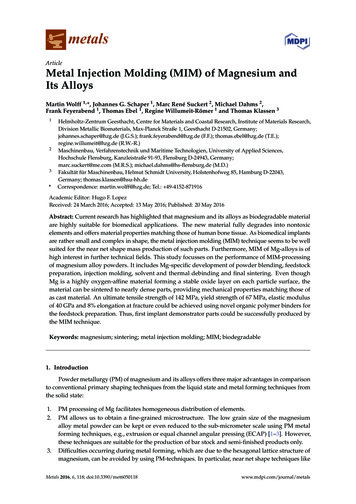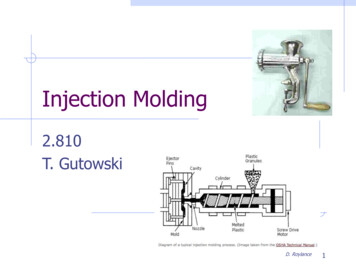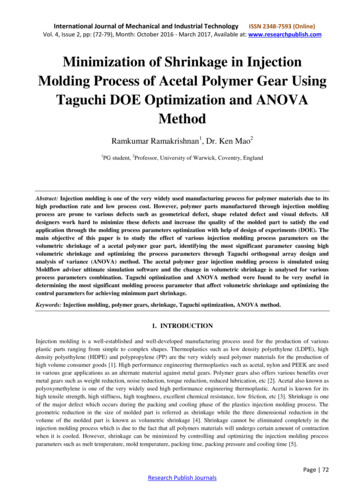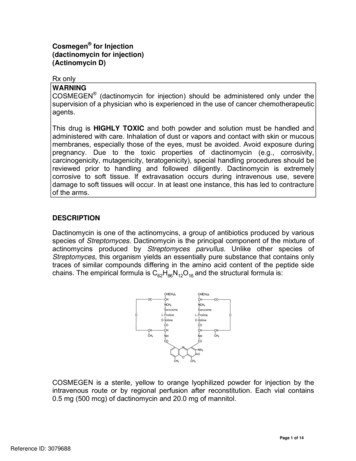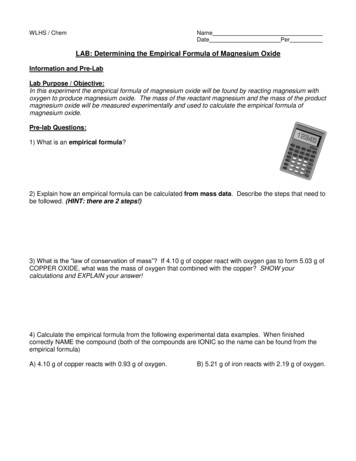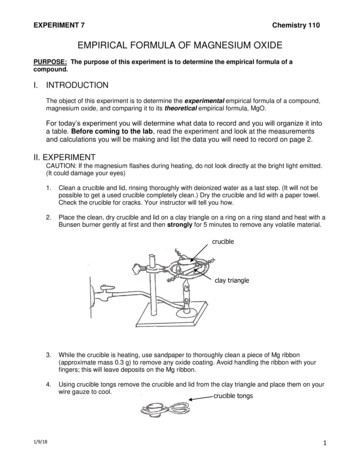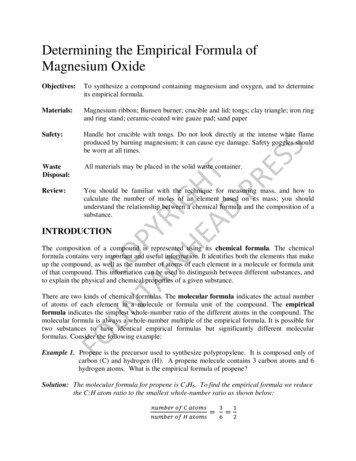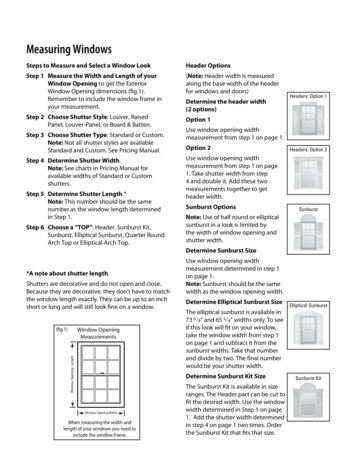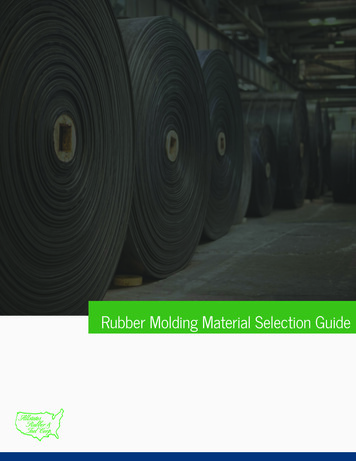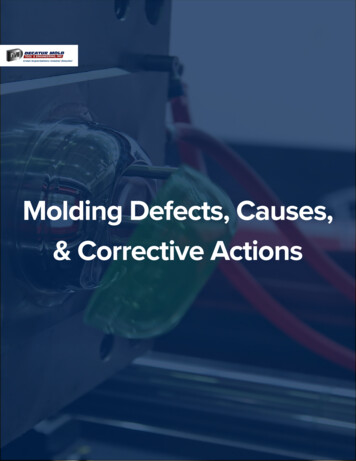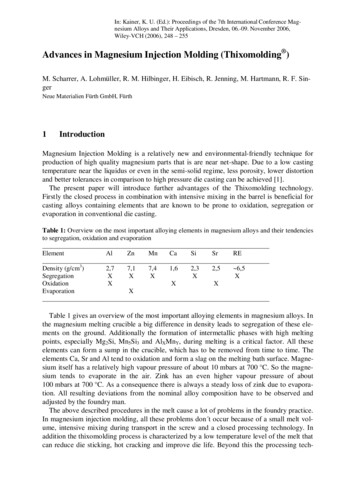
Transcription
In: Kainer, K. U. (Ed.): Proceedings of the 7th International Conference Magnesium Alloys and Their Applications, Dresden, 06.-09. November 2006,Wiley-VCH (2006), 248 –255Advances in Magnesium Injection Molding (Thixomolding )M. Scharrer, A. Lohmüller, R. M. Hilbinger, H. Eibisch, R. Jenning, M. Hartmann, R. F. SingerNeue Materialien Fürth GmbH, Fürth1IntroductionMagnesium Injection Molding is a relatively new and environmental-friendly technique forproduction of high quality magnesium parts that is are near net-shape. Due to a low castingtemperature near the liquidus or even in the semi-solid regime, less porosity, lower distortionand better tolerances in comparison to high pressure die casting can be achieved [1].The present paper will introduce further advantages of the Thixomolding technology.Firstly the closed process in combination with intensive mixing in the barrel is beneficial forcasting alloys containing elements that are known to be prone to oxidation, segregation orevaporation in conventional die casting.Table 1: Overview on the most important alloying elements in magnesium alloys and their tendenciesto segregation, oxidation and evaporationElementAlZnMnCaSiSrREDensity (g/cm3)2,77,17,41,62,32,5 6,5SegregationXXXXXOxidationXXXEvaporationXTable 1 gives an overview of the most important alloying elements in magnesium alloys. Inthe magnesium melting crucible a big difference in density leads to segregation of these elements on the ground. Additionally the formation of intermetallic phases with high meltingpoints, especially Mg2Si, Mn5Si3 and AlXMnY, during melting is a critical factor. All theseelements can form a sump in the crucible, which has to be removed from time to time. Theelements Ca, Sr and Al tend to oxidation and form a slag on the melting bath surface. Magnesium itself has a relatively high vapour pressure of about 10 mbars at 700 C. So the magnesium tends to evaporate in the air. Zink has an even higher vapour pressure of about100 mbars at 700 C. As a consequence there is always a steady loss of zink due to evaporation. All resulting deviations from the nominal alloy composition have to be observed andadjusted by the foundry man.The above described procedures in the melt cause a lot of problems in the foundry practice.In magnesium injection molding, all these problems don t occur because of a small melt volume, intensive mixing during transport in the screw and a closed processing technology. Inaddition the thixomolding process is characterized by a low temperature level of the melt thatcan reduce die sticking, hot cracking and improve die life. Beyond this the processing tech-
nology is similar to polymer injection molding, which allows the development of hot runnersystems that gives thixomolding another unique selling point in comparison to die casting.Scrap can be greatly reduced, heat energy and raw material is saved and flow length duringfilling can be reduced dramatically.In this study processing of a variety of commercial magnesium alloys (AZ, AJ, AS-series)using thixomolding has been investigated. For AZ91 the influence of several processing temperatures (e. g. die temperature, processing temperature and solid phase content) on the mechanical properties is discussed in detail. It is shown that excellent strength and elongationcan be achieved over a wide range of solid phase contents. For all alloys tensile propertiesthat are typical for thixomolding are presented. The trials have been performed at processingtemperatures near the liquidus temperature. A comparison with data from the literature for diecasting is introduced. Furthermore first results for a prototype hot runner system developed atNMF are presented.2ExperimentalThe casting trials carried out on a 220 t - thixomolding machine from Japan Steel Works(JSW) type JLM220-MG. Figure 1 shows a schematic drawing of a thixomolding machine.Figure 1: Schematic drawing of a thixomolding machineThe chipped raw material, delivered by ECKA granules, is dosed into the cylinder using ametering screw. In the cylinder the magnesium granules are heated up and sheared. The heating energy is supplied by electric heater bands. To prevent the magnesium from oxidationargon gas is applied. By the rotation of the screw of about 100 - 200 rpm the magnesium istransported to a melt reservoir in front of the back flow valve. After closing the mold thescrew is moved forward with velocities of about 1 - 4 m/s and the molten metal is shootinginto the cavity. After filling the mold a hold pressure up to 1000 bars can be achieved duringsolidification.Casting trials were done using a mold for separately cast test bars according to ASTMB557 M - 02a. With one shot two tensile bars were cast. The bars had a gage length of50,8 mm and an overall length of 228 mm. Mechanical testing was done using a Zwick/Roell
Z100 tensile testing machine. Table 2 shows the alloy compositions of the raw material measured with the glow discharge optical emission spectroscope (GDOES) GDProfiler from Horiba Jobin Yvon at NMF. Additionally the barrel temperatures used for the comparison withdie casting are mentioned.Table 2: Alloy compositions of the raw material and barrel temperatures during castingElementMgAlZnCaMnSrSnSiTbarrel( 3,70,20,20,7635AS41highbal.4,90,20,20,6630The concentrations of the elements Fe, Ni, Cu were below the ASTM B93-2004 limits.3Results3.1Magnesium-aluminum-alloys (AZ-alloys)An important characteristic of the thixomoldingtechnique is the feasibility to cast the material inthe semi-solid state. The solid phase content iscontrolled by the processing temperature. Former studies have already shown that high volume fractions of solid phase lead to lower porosity, especially in thick walled sections of thecastings [9]. Figure 2 shows the mechanicalproperties of AZ91D as a function of castingtemperature. All casting trials were done with adie temperature of 150 C. Casting parameterslike injection speed and hold pressure had beenconstant (full symbols). With lower casting Figure 2: Mechanical properties of AZ91D as atemperatures, thus higher fraction solid, the ten- function of casting temperature in comparison tosile strength and the elongation seem to de- literature data [3]scend. One of the reasons for this is the reducedheat content of the melt, which results in casting defects like cold flow. This effect has already been discussed in detail [4]. By adjusting the process parameters, the mechanical properties can be significantly raised to the initial values (open symbols). All data are within therange for die casting [3]. Especially tensile strength and elongation are near or above the upper limit.
Another important issue concerning the mechanical properties of magnesium alloys is theirtrong dependency on the grain size [2]. In cast magnesium parts the grain size can be controlled by the solidification rate. Withlower die temperatures, smaller grain sizescan be achieved.Figure 3 shows the mechanical properties of AZ91D as a function of die temperature. The casting temperature was590 C, thus a volume fraction of solids ofabout 12 %. Yield strength rises from145 MPa at 275 C die temperature to 175MPa at 50 C. Metallographic studiesshowed that the grain sizes vary fromabout 10 µm for the lowest temperature to Figure 3: Mechanical properties of AZ91D with a frac20 µm at the highest die temperature. tion solid of about 12 % as a function of die temperatureElongation and tensile strength rise withlower die temperatures too. At 100 C the highest values with 270 MPa and 8 % wereachieved. At 50 C there is a little decline because of some cold flow on the specimens.In Figure 4 the mechanical properties of the alloys AZ70 and AZ91D, cast directly abovethe liquidus temperature, at room temperature and 150 C in comparison to die castliterature data [5] are shown exemplarily.While the properties at room temperature for AZ91 are within the same rangefor both processes, the thixomoldedspecimens are quite better at 150 C(Rp02: 130 MPa, A: 19,3 %).An interesting alternative is the alloyAZ70. At room temperature yield and ten- Figure 4: Mechanical properties of the alloys AZ70 andsile strength are comparable with AZ91, AZ91D at room temperature and 150 Cwhile elongation is significantly higher(A20 C: 11 %, A150 C: 25 %).3.2Magnesium-aluminum-strontium-alloys (AJ-alloys)For components that are used at highertemperatures,Mg-Al-Sr-alloyshavegained importance within the last years.By adding strontium the formation of thephase Mg17Al12, which is believed to bedetrimental concerning creep, is suppressed. Instead other phases like Al4Srare formed. Great attention was paid to theintroduction of the new BMW sixcylinder-aluminum-magnesium-crankcase Figure 5: Mechanical properties of the alloys AJ52 and[]. Nevertheless processing of these alloys AJ62 at room temperature and 150 Cseems to be sophisticated (high casting
temperatures, etc.) [5].Thixomolding trials have been carried out smoothly for AJ52 and AJ62. Figure 5 shows themechanical properties of these alloys at room temperature and 150 C in comparison to conventional die cast data [6]. At room temperature and 150 C all mechanical properties of thethixomolded specimens are significantly better than the reference. In particular thixomoldedAJ52 shows higher elongations up to 20 % at 150 C.3.3Magnesium-aluminum-silicon-alloys (AS-alloys)Another way to get higher creep resistancethan AZ91D is to lower the aluminum content and add some silicon. Because of thelower aluminum content less Mg17 Al12 isformed. The silicon addition leads to formation of the thermal stable Mg2Si phase,which has a melting point of about 1085 C.Silicon-containing alloys have been used inthe VW Beetle. Nowadays the DaimlerChrysler 7G-TRONIC transmission case is Figure 6: Mechanical properties of the alloys AS41lowand AS41high at room temperature and 150 Cproduced using AS31 [10].In this study two AS41-derivates with different aluminum contents were thixomolded. The composition of the AS41low is within therange for AS41 and AS31. Figure 6 shows their mechanical properties. At room temperaturethe yield strength of AS41low is 130 MPa and elongation 13 %. AS41high has 151 MPa and13 % elongation. For both alloys these values are much better than the reference data [7], [8].For 150 C no reference data were available.3.4Hot runner technologyInto the above mentioned die for test bars afirst hot runner system was integrated. The runner system is heated up to the same temperatureas the barrel. Compared to die casting the lowtemperatures are beneficial concerning thechoice of the materials. Corrosion of the construction materials is reduced and an increasedstrength are the most important items. Specialattention has to be paid to the thermal separationof the heated and cooled parts of the mold.Separation of the melt and the cavity is done bya cold plug, which is pushed out before every Figure 7: Different runner systems for tensile barsshot.in thixomolding: conventional runner (left side)Figure 7 shows the first parts cast with this and hot runner (right side)system in comparison to the conventional system. The weight of the normal part is 198 g.Thixomolded tensile bars with the hot runner system have a weight of 139 g. So there is aweight reduction of 30 % for this part. The cycle time was reduced too, because the thickestsection in this part domination the solidification time, is the runner section.
Figure 8 shows the mechanical properties oftest bars cast with conventional system and withhot runner system. They are both on the samelevel due to the fact that the conventional gatingsystem already leads to excellent properties.Bigger advantages in the mechanical propertiesare expected for more complex parts with higherflow length. Melt can be transported directly tothe gates with no loss of thermal energy and bigsolidified runner systems are saved.4ConclusionsFigure 8: Mechanical properties of AZ91D castwith the conventional runner system and the hotrunner systemCasting experiments with a variety of commercial magnesium alloys (AZ-, AJ-, AS-series)and testing at room temperature and 150 C has been carried out in the present paper. Castingexperiments could be realized with no problems regarding to segregation, evaporation andoxidation. Mechanical properties of AZ91D have a strong dependence of die temperature thusthe cooling rate. Mechanical properties are in good agreement with literature data or evenhave better properties.A first hot runner system for a test bar die was developed. Mechanical properties are on thesame level than with cold runner system. 30 % weight reduction was realized and cycle timewas also reduced. This leads to high quality and low cost magnesium parts. In the near futurea mold with a multi point hot runner system will be developed, based on the outcomes of theone point hot runner system.5References[1] Carnahan, R.D., in ASM Specialty Handbook Magnesium and Magnesium Alloys, 1999,p. 90-97[2] Cacares, C.H.; Davidson, C.J.; Griffiths, J.R.; Newton, C.L., Material Science and Engineering A325 (2002), p. 344-355[3] Kompetenz in Magnesium Druckguss, brochure of the Andreas Stihl AG & Co. KG,2002[4] Lohmüller, A.; Scharrer, M.; Hilbinger, M.; Jenning, R.; Hartmann, M.; Singer, R.F.,Giessereiforschung 57 (2005) Nr. 1, p. 2-9[5] Aghion, E.; Bronfin, F.; von Buch, R.; Schumann, S.; Friedrich, H., JOM, November2003, p. 30-33[6] Baril, E.; Labelle, P.; Pekguleryuz, M.O., JOM, November 2003, p. 34-39[7] Hydro Magnesium, Zusammensetzung und Eigenschaften von Magnesium Druckgusslegierungen, 2005[8] Hydro Magnesium, Datenblatt Magnesium Druckguss Legierungen, 2001
[9] Lohmüller, A.; Scharrer, M.; Jenning, R.; Hilbinger, M.; Hartmann, M.; Singer, R.F.,Magnesium, Proceedings of the 6th international conference magnesium alloys and applications, 2003, p. 738-743[10] Barth, A, lecture at the 62nd annual world magnesium conference, Berlin, 2005
Magnesium Injection Molding is a relatively new and environmental friendly technique for production of high quality magnesium
